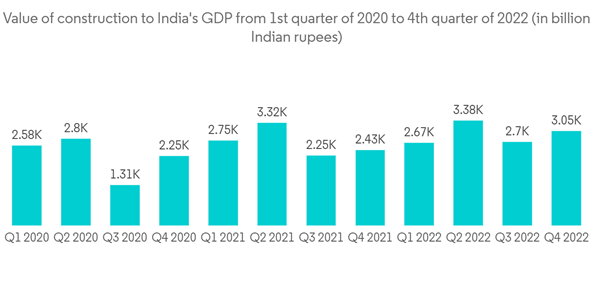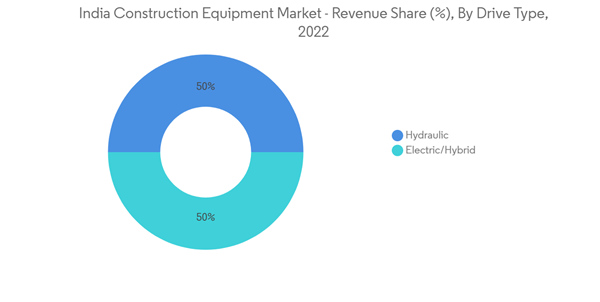The India construction equipment market was valued at USD 7.91 billion in 2024, and it is expected to reach USD 11.8 billion by 2029, projecting a CAGR of 8.3% during the forecast period (2024 - 2029).
Various companies operating in the ecosystem are actively engaging in forming partnerships and collaborations and launching new products to enhance their brand presence and expand their business capability across India. For instance,
In January 2023, Komatsu India displayed their new product named HB365LC-1 hybrid excavator at the ConExpo India Trade Fair 2023 in Noida-NCR. The product is claimed to be at least 20% more energy efficient and helps reduce carbon emissions compared to conventional equipment.
In November 2022, JCB India announced its partnership with Federal Bank, a private sector lender, to boost financing options of prospective buyers willing to purchase construction equipment. Under the arrangement, Federal Bank will be the preferred finance partner of the construction equipment manufacturer, where JCB's customers can avail of loans from the lender at competitive interest rates.
This product will be delivered within 2 business days.
Key Highlights
- Improvement in road construction infrastructure, increasing urbanization rate, and higher investment to boost infrastructure activities serve as the major determinants for the growth of construction equipment in India. With better road transportation infratructure and a rise in urban population, there exists a greater demand for convenience in personal mobility, healthcare, sanitation, and water supply, among others, which in turn contributes to the boosting demand for construction equipment, attributed to the growth in the construction sector across India. For instance,
- The urban population as a percentage of the overall population in India stood at 36% in 2022, compared to 34% in 2018. As more consumers shift to urban spaces for better employment and financial opportunities, various states must enhance their transportation infrastructure to adapt to the growing urban population, which would, in turn, positively impact the construction equipment market in India.
- Coupled with that, the government's investment in developing an efficient road connectivity infrastructure propels the demand for construction equipment market in India owing to the rise in construction activities. In June 2023, the Ministry of Highways and Transport notified that the total length of the national highways in the country increased by about 59% in the last nine years. The total length of National Highways stood at 91,287 km in 2013-14, which increased to 1,44,634 km as of 30 November 2022. Rapid improvement and investment in enhancing national highway infrastructure assist in the surging demand for advanced construction equipment products in India.
- One of the major challenges faced by the industry is the increasing demand for rental construction equipment, which hinders the growth of new construction equipment sales. The purchase of this equipment is an expensive affair. Therefore, construction contractors prefer to avail of rental services rather than invest in expanding their construction equipment fleet. Further, the cost for replacement and maintenance is exorbitantly high, which leads to various construction companies renting these machinery rather than purchasing new equipment.
- However, with the integration of technologically advanced products in the market and advancement and the growth in the real estate sector anticipated in the coming years, the demand for construction equipment to witness a rapid surge. The government of India's Housing for All 2022 initiative is expected to bring USD 1.3 trillion in investments in the housing sector by 2025. Further, the Pradhan Mantri Awas Yojana (Urban) [PMAY (U)] scheme is expected to push affordable housing and construction in the country and give a boost to the real estate sector. Substantial investment in the real estate sector will drive higher demand for the construction equipment market in India for renovation and new building construction activities.
India Construction Equipment Market Trends
Increasing Government Spending on Construction and Infrastructure Development
- Increasing government spending and higher foreign direct investment (FDI) to enhance the infrastructure development of the country serve as the major catalyst for the growth of the construction equipment market in India. According to the Indian Construction Equipment Manufacturers' Association (ICEMA), 85.39 thousand units of construction equipment were sold in FY 2022. Although the sales volume has not been able to showcase pre-COVID numbers, with the aggressive focus of the government to improve the construction sector, sales of construction equipment are anticipated to showcase a rapid boost in the coming years.
- Under the Budget 2023-2024, the government of India has announced various measures to support the infrastructure development of the country. For instance, the Union Budget indicated the capital investment outlay for infrastructure to increase by 33% to INR10 lakh crore (USD 122 billion), which would be 3.3 percent of GDP and almost three times the outlay in 2019-20. Further, the budget also portrays an establishment of the Infrastructure Finance Secretariat to enhance opportunities for private investment in infrastructure that will assist all stakeholders in more private investment in infrastructure, including railways, roads, urban infrastructure, and power.
- Coupled with that, the government of India's massive push to attract foreign and domestic investments for the infrastructure sector will positively fuel the demand for construction equipment in the coming years. For instance, in November 2022, the National Investment and Infrastructure Fund (NIIF) was set up as a collaborative investment platform between the Government of India, global investors, multilateral development banks (MDB), and domestic financial institutions to facilitate investment across multiple sectors in India through an India Japan Fund.
- In June 2022, the Minister of Road Transport and Highways opened 15 national highway projects worth Rs. 13,585 crores (US$1.7 billion) in Patna and Hajipur, Bihar.
- Further, the Indian construction market has witnessed a surge in foreign direct investment in recent years, positively impacting the construction equipment market. In FY 2022, foreign direct investment (FDI) in India's construction and infrastructure activities stood at USD 3,248 million. Subsequently, in FY 2023 (April-December), the FDI inflow touched USD 1,221 million. Moreover, government programs and projects such as Ujwal Discoms Assurance Yojana (UDAY), Smart City Mission, Pradhan Mantri Awas Yojana, Gati Shakti Master Plan, and Bharstmala project propels the market's growth. These programs and projects envisaged are anticipated to fuel the demand and usage of construction equipment in India.
Electric/Hybrid Construction Equipment Segment of the Market to Gain Traction in the coming years
- Shifting preferences of businesses to promote the use of eco-friendly products, coupled with the increasing push by the government to combat carbon emissions, will propel the electric/hybrid construction equipment segment of the market, which is expected to record a massive surge in the coming years.
- The Indian government has introduced various initiatives and policies to encourage the use of electric vehicles and machinery, such as the Faster Adoption and Manufacturing of Electric Vehicles (FAME) scheme. Under this scheme, financial incentives and subsidies are provided to manufacturers and buyers of electric vehicles, including construction equipment.
- The Indian government has committed to strengthening the emissions intensity of its GDP to 45% by 2030 from 2005 levels. Further, the government has also unveiled a plan to reach a carbon-neutral economy by 2070.
- To promote the use of electric construction equipment, the government of India has taken active measures to draft regulations that oversee the use of electric powertrains in construction equipment under AIS 156 and AIS 168 regulations (Automotive Industry Standard). This regulation indicates various requirements that electric construction equipment must possess to be sold in the Indian market.
- In March 2022, The central government set up a Technology Sub-Mission (TSM) under the Pradhan Mantri Awas Yojana-Urban (PMAY-U) to facilitate the adoption of modern, innovative, green technologies and building materials for housing construction. TSM enables the preparation and adoption of layout designs and building plans suitable for various geo-climatic zones and helps the states and cities to deploy disaster-resistant and environment-friendly technologies.
- Various companies operating in the Indian market are diversifying their product portfolio to launch electric/hybrid construction equipment products to cater to the growing demand of consumers. For instance,
- In June 2023, Action Construction Equipment (ACE), a material handling and construction equipment manufacturing company, announced the launch of its first fully electric mobile crane in India at the Bauma Conexpo 2023 Trade Fair in Greater Noida.
- In June 2023, Volvo CE India announced a partnership with Vedanta Iron Ore Karnataka by signing a Memorandum of Understanding (MoU) to deploy sustainable power solutions, such as zero-emission electric off-road machines, at Vedanta IOK's mines in Chitradurga on a trial basis.
- Further, JCB has been actively engaging in launching various construction electric equipment products in India, such as the Electric Excavator named JCB 19C-1E.
- With more companies adopting an eco-friendly policy, the market for electric/hybrid equipment will gain massive traction in the coming years.
India Construction Equipment Industry Overview
The market is moderately fragmented and competitive, with various domestic and international companies operating across India. Some of the major players include Caterpillar, Komatsu, Volvo Construction Equipment, JCB, Tata Hitachi Construction Machinery, XCMG, SANY, and Hyundai Construction Equipment, among others. These players compete based on various parameters such as price, diversified product portfolio, financing options, maintenance & repair support, and geographical coverage across India, among others.Various companies operating in the ecosystem are actively engaging in forming partnerships and collaborations and launching new products to enhance their brand presence and expand their business capability across India. For instance,
In January 2023, Komatsu India displayed their new product named HB365LC-1 hybrid excavator at the ConExpo India Trade Fair 2023 in Noida-NCR. The product is claimed to be at least 20% more energy efficient and helps reduce carbon emissions compared to conventional equipment.
In November 2022, JCB India announced its partnership with Federal Bank, a private sector lender, to boost financing options of prospective buyers willing to purchase construction equipment. Under the arrangement, Federal Bank will be the preferred finance partner of the construction equipment manufacturer, where JCB's customers can avail of loans from the lender at competitive interest rates.
Additional Benefits:
- The market estimate (ME) sheet in Excel format
- 3 months of analyst support
This product will be delivered within 2 business days.
Table of Contents
1 INTRODUCTION
4 MARKET DYNAMICS
5 MARKET SEGMENTATION (Market Size in Value - USD)
6 COMPETITIVE LANDSCAPE
7 MARKET OPPORTUNITIES AND FUTURE TRENDS
Methodology

LOADING...










